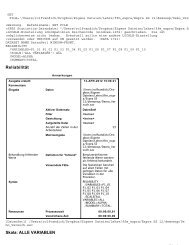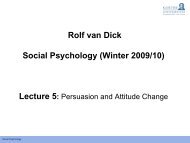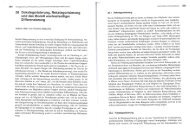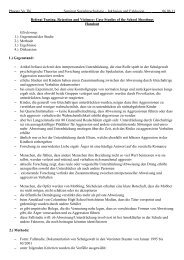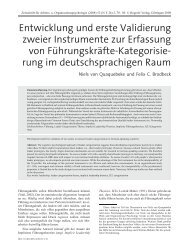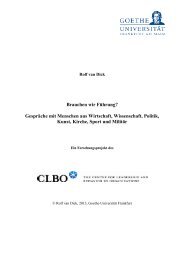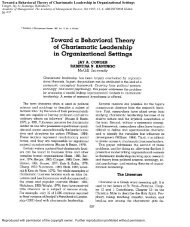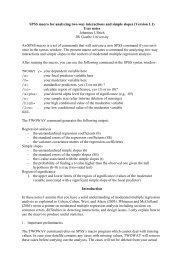central route to persuasion - Sozialpsychologie
central route to persuasion - Sozialpsychologie
central route to persuasion - Sozialpsychologie
Create successful ePaper yourself
Turn your PDF publications into a flip-book with our unique Google optimized e-Paper software.
Rolf van Dick<br />
Social Psychology (Winter 2011/12)<br />
Lecture 5: Persuasion and Attitude Change<br />
Social Psychology
Sample MC-Items (last week)<br />
1) According <strong>to</strong> which model are attitudes described variously as<br />
containing feelings, likes, dislikes, behavioural intentions,<br />
thoughts and ideas?<br />
A) the three component model B) the dual model of attitudes<br />
C) the cognitive consistency model D) the one-component model<br />
2) Dissonance theory and balance theory are both examples of:<br />
A) accidental discoveries in the study of attitudes<br />
B) cognitive consistency theories<br />
C) social identity theory<br />
D) behaviourism in the study of attitudes<br />
Social Psychology
Sample MC-Items (last week)<br />
3) The theory of planned behaviour extended the theory of reasoned<br />
action by:<br />
A) specifying the questions that are asked in order <strong>to</strong> predict behaviour<br />
B) re-arranging the three components of “beliefs“, “intentions“ and<br />
“action“<br />
C) adding the variable of perceived behavioural control<br />
D) defining “intention“<br />
4) In balance theory, a triad is balanced when there is (are):<br />
A) two positive relationships<br />
B) just one negative relationship<br />
C) an odd number of negative relationships<br />
D) none of the above<br />
Social Psychology
Schedule<br />
1. Introducing Social Psychology 19.10.<br />
2. Attribution and Social Knowledge 26.10.<br />
3. Self and Identity 02.11.<br />
4. Attitudes 09.11.<br />
5. Persuasion and Attitude Change 16.11.<br />
6. Social Influence 23.11.<br />
7. People in Groups 30.11.<br />
8. Prejudice and Discrimination 07.12.<br />
9. Intergroup Behavior 14.12.<br />
10.Leadership and Decision Making 21.12<br />
11.Aggression 11.01.<br />
12.Affiliation, Attraction, and Love 18.01.<br />
13.Prosocial Behavior 25.01.<br />
14.Revision 01.02.<br />
15.Exam 08.02.
Social Psychology<br />
Some terms (1/2)<br />
• Persuasion - Überzeugung/Überredung<br />
• neatly – ordentlich<br />
• extraneous – von außen<br />
• <strong>to</strong> enhance – fördern / steigern<br />
• uptight – angespannt<br />
• distracted – zerstreut<br />
• compliance – Folgsamkeit / Fügsamkeit<br />
• <strong>to</strong> enhance – erleichtern<br />
• ingratiation – Anbiederung<br />
• <strong>to</strong> emphasise - be<strong>to</strong>nen<br />
• Elaboration-likelihood model – Modell der Verarbeitungstiefe<br />
• attempt - Versuch<br />
• Inoculation – Impfung
Some terms (2/2)<br />
• trustworthiness – Vertrauenswürdigkeit / Zuverlässigkeit<br />
• Source derogation – Abwertung der Quelle (der Botschaft)<br />
• tedium – Überdruss<br />
• slight – ein wenig<br />
• heuristics – Faustregeln<br />
• superficial – oberflächlich<br />
• <strong>to</strong> preserve – bewahren / beibehalten<br />
• obvious – offensichtlich<br />
• <strong>to</strong> induce – herbeiführen / bewegen<br />
• assault – Angriff<br />
• conformity - Angepasstheit<br />
Social Psychology
Focus Question<br />
You have just joined the army. Along with other cadets you listen <strong>to</strong> an<br />
amazing talk by an officer skilled in the use of survival techniques in<br />
difficult combat conditions. Among other things, he asks you <strong>to</strong> eat<br />
some fried grasshoppers. „Try <strong>to</strong> imagine this is the real thing! You<br />
know, you might have <strong>to</strong> do this <strong>to</strong> save your live one day“, he says.<br />
Despite your first reaction, you go ahead and eat them. Would you end<br />
up liking the delicacy more if the officer„s style of presentation was<br />
warm and friendly or cold and distant?<br />
Social Psychology
In General<br />
Teaching objectives<br />
The various models of the <strong>persuasion</strong> process; tactics for<br />
enhancing compliance; the theory of cognitive<br />
dissonance and fac<strong>to</strong>rs which guard against attitude<br />
change.<br />
Social Psychology
Teaching objectives<br />
Specific <strong>to</strong>pics<br />
Attitudes, arguments and behaviour<br />
Persuasive communications<br />
Compliance: Interpersonal influence<br />
Attitude behaviour discrepancy and cognitive dissonance<br />
When attitude change fails<br />
Social Psychology
The <strong>persuasion</strong> process:<br />
communica<strong>to</strong>r, message, and audience<br />
The field of attitude change is vast and complex.<br />
Hovland headed the Yale approach <strong>to</strong><br />
communication and <strong>persuasion</strong>, which studied<br />
variables dealing with the communica<strong>to</strong>r, the<br />
source of the message, the message itself, and<br />
the context in which <strong>persuasion</strong> occurs.<br />
Social Psychology
The Yale approach <strong>to</strong> communication and <strong>persuasion</strong><br />
Social Psychology<br />
Based on Janis & Hovland (1959).
The effect of communica<strong>to</strong>r credibility and position<br />
discrepancy on opinion change<br />
Social Psychology<br />
Based on data from Bochner & Insko (1996).
The effects of source modality and message<br />
difficulty on opinion change<br />
Social Psychology<br />
Based on Chaiken & Eagly (1983).
The effect of fear arousing messages<br />
Fear-arousing communications are most<br />
effective if they induce a moderate amount of<br />
fear and people believe that listening <strong>to</strong> the<br />
message will reduce this fear. If the<br />
message is <strong>to</strong>o scary or not scary enough, it<br />
will fail.<br />
Social Psychology
Social Psychology<br />
The inverted U-curve relationship between<br />
fear and attitude change
The <strong>persuasion</strong> process:<br />
communica<strong>to</strong>r, message, and audience<br />
• Several aspects of a communica<strong>to</strong>r affect<br />
whether a person is evaluated favorably.<br />
– Credibility<br />
• Expertise<br />
• Trustworthiness<br />
– Liking<br />
Social Psychology
The <strong>persuasion</strong> process:<br />
communica<strong>to</strong>r, message, and audience<br />
• We are persuaded by the opinions of our<br />
reference groups, those we like or identify<br />
with.<br />
– This occurs both because of the motivational<br />
fac<strong>to</strong>rs of liking and perceived similarity, and<br />
because messages from in-groups are more likely<br />
<strong>to</strong> be processed using the <strong>central</strong> <strong>route</strong> (see ELM<br />
later).<br />
Social Psychology
The <strong>persuasion</strong> process:<br />
communica<strong>to</strong>r, message, and audience<br />
• Source derogation involves deciding the source<br />
is unreliable or negative in some way. It can<br />
make all future as well as current arguments<br />
from that source less powerful.<br />
Social Psychology
The <strong>persuasion</strong> process:<br />
communica<strong>to</strong>r, message, and audience<br />
• Repetition and familiarity tend <strong>to</strong> increase<br />
liking, but only up <strong>to</strong> a point.<br />
• Repetition may help people process strong<br />
arguments more completely but expose the flaws in<br />
weak arguments.<br />
• Repetition may lead <strong>to</strong> tedium; this can be dealt<br />
with by having ads that provide slight variations on<br />
a theme.<br />
Social Psychology
Dual process models of <strong>persuasion</strong><br />
Two important areas of our lives that employ relevant<br />
principles from social psychological research are<br />
advertising and political propaganda.<br />
Two models, each dealing with how a persuasive message<br />
is learned, draw on developments in research on<br />
cognition. Petty and Cacioppo‟s elaboration likelihood<br />
model proposes that, when people attend <strong>to</strong> a message<br />
carefully, they use a <strong>central</strong> <strong>route</strong> <strong>to</strong> process it; otherwise<br />
they use a peripheral <strong>route</strong>. Chaiken‟s heuristic–<br />
systematic model suggests that people use systematic<br />
processing when they attend <strong>to</strong> a message carefully;<br />
otherwise they use heuristic processing.<br />
Social Psychology
Dual process models of <strong>persuasion</strong><br />
Both theories state that under certain<br />
conditions, people are motivated <strong>to</strong> pay<br />
attention <strong>to</strong> and think about the facts in a<br />
message; this is referred <strong>to</strong> as the <strong>central</strong><br />
<strong>route</strong> <strong>to</strong> <strong>persuasion</strong>.<br />
Social Psychology
Dual process models of <strong>persuasion</strong><br />
Under other conditions, people are not<br />
motivated <strong>to</strong> pay attention <strong>to</strong> the facts a<br />
message presents and only attend <strong>to</strong><br />
superficial characteristics such as who<br />
delivers it and how long it is. In this case<br />
people may be influenced by the peripheral<br />
<strong>route</strong> <strong>to</strong> <strong>persuasion</strong>.<br />
Social Psychology
Dual process models of <strong>persuasion</strong><br />
CENTRAL<br />
ROUTE<br />
PERI-<br />
PHERAL<br />
ROUTE<br />
Social Psychology
The elaboration–likelihood<br />
model of <strong>persuasion</strong><br />
Petty & Cacioppo (1986)<br />
Social Psychology
Dual process models of <strong>persuasion</strong><br />
Which <strong>route</strong> <strong>to</strong> attitude change will people<br />
take? One determinant is the personal<br />
relevance of the <strong>to</strong>pic. The more relevant the<br />
<strong>to</strong>pic, the more people will take the <strong>central</strong><br />
<strong>route</strong> <strong>to</strong> <strong>persuasion</strong>. Here, they will be<br />
influenced the most by the strength of the<br />
arguments.<br />
Social Psychology
Social Psychology<br />
Dual process models of <strong>persuasion</strong>
Einstellung (Semantisches Differential, STDR)<br />
-1.0 -0.5 0.0 0.5 1.0<br />
Results Live-Experiment<br />
BSc 2009<br />
Einstellung zu Klausuren / Ergebnisse Vorlesung<br />
schwache Argumente<br />
starke Argumente<br />
niedrige Relevanz<br />
hohe Relevanz<br />
Social Psychology
Dual process models of <strong>persuasion</strong><br />
The <strong>route</strong> <strong>to</strong> attitude change also depends on<br />
people‟s ability <strong>to</strong> pay attention <strong>to</strong> the<br />
arguments. The more distracted people are,<br />
the more they will take the peripheral <strong>route</strong>.<br />
Attitude change will be more long-lasting if it<br />
occurs through the <strong>central</strong> <strong>route</strong>.<br />
Social Psychology
Dual process models of <strong>persuasion</strong><br />
In order <strong>to</strong> get people <strong>to</strong> use the <strong>central</strong><br />
processing <strong>route</strong>, you need <strong>to</strong> get their<br />
attention. This can be done by playing <strong>to</strong><br />
their emotions.<br />
Social Psychology
Dual process models of <strong>persuasion</strong><br />
However, people want <strong>to</strong> preserve good<br />
moods, so they will avoid activities that might<br />
spoil their good mood. This means that<br />
people in good moods will often avoid paying<br />
close attention <strong>to</strong> a persuasive<br />
communication, because they think that doing<br />
so will lower their mood.<br />
Social Psychology
Tactics for enhancing compliance<br />
A variety of techniques that deal with ways of<br />
inducing another person <strong>to</strong> comply with our<br />
requests has been intensively studied: these<br />
include ingratiation, reciprocity and guilt arousal.<br />
There are also multiple-request techniques (footin-the-door,<br />
door-in-the-face and low-balling), in<br />
which a first request functions as a set-up for the<br />
second, real request.<br />
Social Psychology
Social Psychology<br />
Three classic techniques for inducing compliance
The foot-in-the-door technique: compliance with an<br />
impossible request followed by a possible request<br />
Based on data from<br />
Dolinski (2000), Experiment 2<br />
Social Psychology
The theory of cognitive dissonance<br />
Festinger‟s cognitive dissonance theory is a major<br />
approach <strong>to</strong> the <strong>to</strong>pic of attitude change. It<br />
addresses not only conflict between a person‟s<br />
beliefs but discrepancy between behaviour and<br />
underlying attitudes, and behaviour and selfconception.<br />
It includes three variations on the<br />
way in which dissonance is brought about: effort<br />
justification, induced compliance and free<br />
choice.<br />
Social Psychology
The effect of incentives on evaluating a boring task<br />
in an induced- compliance context<br />
Social Psychology<br />
Based on data from Festinger & Carlsmith (1959).
Social Psychology<br />
The theory of cognitive dissonance
Interest in a group discussion in relation <strong>to</strong> the<br />
severity of the initiation procedure<br />
Based on data from Aronson & Mills (1959).<br />
Social Psychology
Change in weight among overweight women after<br />
expending psychological effort<br />
Social Psychology<br />
Based on data from Cooper & Axom (1982).
Degree of liking fried grasshoppers as food by military<br />
cadets in relation <strong>to</strong> the interpersonal style of an officer<br />
Based on data from Zimbardo, Weisenberg, Fires<strong>to</strong>ne & Levy (1965).<br />
Social Psychology
Resistance <strong>to</strong> <strong>persuasion</strong><br />
Reactance is an increase in resistance <strong>to</strong><br />
<strong>persuasion</strong> when the communica<strong>to</strong>r‟s efforts <strong>to</strong><br />
persuade are obvious. Techniques for building<br />
up resistance include forewarning and the<br />
inoculation defence. In recent years,<br />
manufacturing companies have used inoculating<br />
media releases <strong>to</strong> shore up consumer loyalty.<br />
Social Psychology
Resistance <strong>to</strong> <strong>persuasion</strong><br />
• Attitude Inoculation<br />
One way <strong>to</strong> bolster people against <strong>persuasion</strong><br />
attempts is <strong>to</strong> have them consider the arguments for<br />
and against their attitude before somebody attacks it.<br />
Social Psychology
Resistance <strong>to</strong> <strong>persuasion</strong><br />
• Attitude Inoculation<br />
McGuire (1964)<br />
Attitude inoculation procedure does this by exposing<br />
people <strong>to</strong> a small dose of the argument against their<br />
position; this induced them <strong>to</strong> counter-argue and<br />
provide a “vaccination” that helps people ward off<br />
later, stronger influence attempts.<br />
Social Psychology
Resistance <strong>to</strong> <strong>persuasion</strong><br />
• Resisting Peer Pressure<br />
Attitude inoculation that is designed <strong>to</strong> combat<br />
affectively based <strong>persuasion</strong> techniques can be<br />
effective at helping people resist peer pressure.<br />
Social Psychology
Resistance <strong>to</strong> <strong>persuasion</strong><br />
• When Persuasion Attempts Boomerang:<br />
Reactance Theory<br />
Brehm (1966)<br />
It is important not <strong>to</strong> use <strong>to</strong>o heavy a hand when trying<br />
<strong>to</strong> persuade people. If you administer <strong>to</strong>o strong a<br />
prohibition (e.g. alcohol consumption, smoking), the<br />
prohibition may boomerang and lead <strong>to</strong> an increase in<br />
the prohibited activity.<br />
Social Psychology
Resistance <strong>to</strong> <strong>persuasion</strong><br />
• When Persuasion Attempts Boomerang:<br />
Reactance Theory<br />
Reactance theory explains this by saying that strong<br />
prohibitions threaten a person‟s feeling of freedom,<br />
and engaging in the forbidden behavior is an attempt<br />
<strong>to</strong> res<strong>to</strong>re that feeling of freedom.<br />
Social Psychology
Literature, Film and TV<br />
• Tin Men: 1987 comedy written and directed by Barry Levinson,<br />
starring Richard Dreyfuss and Danny Devi<strong>to</strong>. Two aluminium<br />
salesmen are in competition. They use all their skills <strong>to</strong> outsell each<br />
other by persuading cus<strong>to</strong>mers.<br />
• Matchstick Men: 2003 black comedy by Ridley Scott, starring<br />
Nicholas Cage. A pair of con artists spend their lives engaging in<br />
<strong>persuasion</strong> and living a double life <strong>to</strong> avoid being caught. They pull<br />
off scams, but the last huge scam backfires big time on Nicholas<br />
Cage‟s character who becomes the victim of his own con.<br />
• Glengarry Glen Ross: 1992 film directed by James Foley, written by<br />
David Mamet, and starring Jack Lemmon, Al Pacino, Ed Harris,<br />
Kevin Spacey, Alec Baldwin and others. The film is about real estate<br />
office and the different ways in which salesmen under pressure try<br />
<strong>to</strong> sell, and <strong>to</strong> persuade others.<br />
Social Psychology
Your Portfolio<br />
• Read the chapter along the slides!<br />
• Answer the sample questions!<br />
• What have I learned?<br />
• What did I NOT understand?<br />
• How can I apply the knowledge?<br />
Social Psychology
Sample MC-Items<br />
1) When Karen hears graphic news about disasters she becomes<br />
somewhat stressed, focussed and attentive. However, when she<br />
gets extremely stressed, she is so uptight that she becomes<br />
distracted from the details of the s<strong>to</strong>ry. This sequence<br />
characterises the:<br />
A) J-curve B) boomerang effect<br />
C) reactance response D) the inverted U-curve<br />
2) In Petty and Cacioppo‘s (1986) elaboration-likelihood model<br />
A) people are never assumed <strong>to</strong> take mental shortcuts<br />
B) a <strong>central</strong> <strong>route</strong> is used when the message is delivered in visual form<br />
C) a peripheral <strong>route</strong> is used when attention <strong>to</strong> the argument of a<br />
message is low<br />
D) <strong>persuasion</strong> occurs only when the source is likeable<br />
Social Psychology




